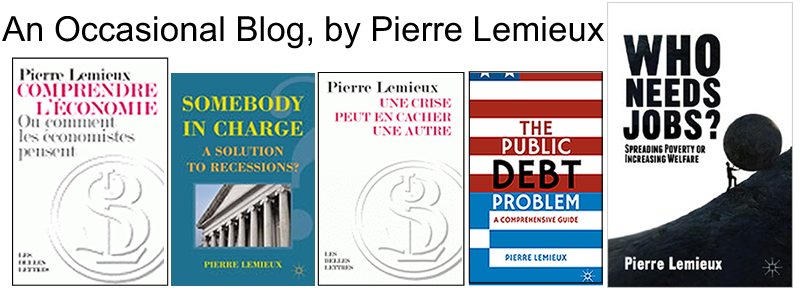At the end of November, Goldman Sachs predicted a short-term (over a three-month horizon) increase in the price of gold, followed by a downward trend through 2014. Accompanied by a new, bullish outlook for the American economy, this bearish forecast for gold made the financial news (see for example the Financial Times of December 7, 2012). Since then, the price of gold has been trending downwards, but things could change.
This sort of forecast raises interesting questions on the factors that influence the price of the yellow metal.
The heavy black curve on the figure below shows the variations of gold prices over the past few decades. The breakdown of the official peg of the dollar at $35 per ounce of gold in 1971 along with mounting inflation and unemployment brought gold to $675 in January 1980. Like other figures used here, this is a monthly average that hides some further variations: on January 21, 1980, gold reached a summit of $850. Then, with an improving economy, gold started a long, irregular decline until bottoming out at $256 in July 1999. It soon started moving up again, tripling by the fall of 2007. With the uncertainties of the Great Recession, it continued on the same path, more than doubling to $1,772 by September 2011. It has since fluctuated between roughly $1,600 and $1,800.
The dotted curve represents the price of gold in real dollars of today (November 2012) and shows still wider fluctuations. In these constant dollars, the price of gold had still not reached its peak of 1980.
How gold prices will move in the future is of course impossible to know, but we can identify broad factors that will exert an influence. The higher the rate of interest, the less attracted investors are to an asset that yields no return like gold; the lower the rate of interest, the more attractive gold becomes. As interest rates are very low, they might be expected to increase (or at least not to drop further) in the future, dampening any bullish outlook for gold. Another factor is that investors view gold as a safe-haven asset, so that its price rises as the economic outlook worsens; conversely, it can be expected to fall if one is bullish on the economy as Goldman Sachs is.
There is another, more general lesson to be learned. It is important to understand that the price of gold depends on the demand for gold (given the existing stock of the metal), which itself depends on individual preferences. Ultimately, in the economy, everything is subjective. Prices change because people change their minds. In a deep sense, gold is no more physical or “real” than any other asset: it is what people think it is, and is valued as such.
The price of gold, like all prices, is a relative price, nothing more. The price of gold in terms of dollars is the inverse of the price of dollars in terms of gold. The price of gold does not necessarily go up, as can be seen over the past decades. As a relative price, it can be calculated in terms of any other good (consumption good or asset). The price of gold in terms of dollars is interesting only because this is how it is usually quoted, and because many people who buy gold use dollars, and many who sell gold want dollars (that is, they buy dollars with gold).
Although the relative price of gold in terms of dollars and probably in terms of most goods is higher than it was in the early 1970s, a longer historical perspective would likely reveal goods that are now more expensive in terms of gold than they were at some point. In other words, gold can depreciate.
The red curve on the figure serves to illustrate that the price of gold is only a relative price that can be calculated in terms of any other good. The curve follows the price of one ounce of gold in terms of a standard unit of medical care in the U.S. (The price of a standard unit of medical care is calculated with the sub-index of medical care in the Consumer Price Index.) The price of gold in medical care is of course the inverse of the price of medical care in gold.
Because the price of medical care has increased faster than the CPI over the past three decades, the price of gold in terms of medical care has been decreasing at a still faster pace since its peak of 1980—faster than the price of gold in terms of a typical basket of consumer goods, as given by the heavy black curve. The price of gold in terms of medical care dropped by 90% between January 1980 and April 2001. In November 2012, the price of gold in terms of medical care was still 57% lower than it was in January 1980. If it were used as money, gold would now buy less than half as much medical care as in early 1980.
As Goldman Sachs suggests, the price of gold could fall again. My own guess is that it will not, or at least not for long, as the public debt crisis deepens and grips America. But the main lesson of the variability gold prices is deeper: although the yellow metal may (or may not) be a good potential anchor for money and an efficient restraint on Leviathan, it is certainly not an absolute standard of value and should not venerated as a fetish.
Gold Prices, Monthly Averages, December 1969 to November 2012
 Sources: FRED (Federal Reserve Economic Data), Bureau of Labor Statistics, and author’s calculations.
Sources: FRED (Federal Reserve Economic Data), Bureau of Labor Statistics, and author’s calculations.
